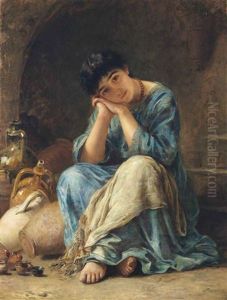David Edwin Paintings
David Edwin was an American engraver born in Bath, Somerset, England, in the year 1776. He was the son of John Edwin, a well-regarded comic actor of his time. Despite his British birth, Edwin's most influential work occurred after he moved to the United States, where he became one of the most prominent engravers of the early 19th century.
Edwin received his early training in the arts from his father, who had a keen interest in drawing and etching. Later in his youth, he apprenticed with the notable British engraver P.W. Tomkins, who was a pupil of Francesco Bartolozzi, a highly influential figure in the art of stipple engraving. This training provided Edwin with a strong foundation in the techniques that he would later employ in his work.
In 1797, seeking better prospects, Edwin emigrated to Philadelphia, which was then a burgeoning center for the arts in the United States. His timing was fortuitous; Philadelphia was in need of skilled engravers to illustrate books, banknotes, and to create portraits and historical scenes. Edwin's style, characterized by delicate lines and a keen attention to detail, quickly gained him recognition and commissions.
Throughout his career, Edwin worked on a variety of projects, including book illustrations, portraits, and banknotes. He also engraved plates for the popular magazine 'The Port Folio.' One of his most notable works is the engraving of the 'Declaration of Independence,' which was based on the painting by John Trumbull. This piece solidified Edwin's reputation as a master engraver.
Despite his success, Edwin's life was not without hardship. The financial panic of 1819 and the subsequent economic downturn had a considerable impact on his career. The market for luxury items, such as engravings, diminished, and Edwin struggled financially during this period. Nevertheless, he continued to work and contribute to the arts until his death in Philadelphia in 1841.
David Edwin's legacy lies in the quality and beauty of his engravings which captured the spirit of the young American nation. He left behind a body of work that continues to be appreciated for its craftsmanship and historical value. Edwin's contribution to the arts is remembered as a significant part of the American cultural heritage of the early 19th century.
